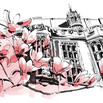Library Exhibits Highlight Yale and Literary History

The Lillian Goldman Law Library presents two new rare book exhibits for the first half of 2025. “Max and Trix” and “Flowers at Lambach” will both be on display from Jan. 13 to May 25 of this year.
“Max and Beatrix Farrand: Memory and Landscape at Yale4” commemorates the life and work of Max Farrand, professor in the Yale history department, and Beatrix Cadwalader Jones Farrand, a prominent landscape architect and influence on the American campus. The Farrands married in 1913 and moved to a house on Prospect Street in New Haven, where their story would weave together with those of other Yale affiliates: Standard Oil titans, philanthropists, and architects working at this nexus between industrial fortunes and the institution of the American university.

As Yale’s first consultant gardener, Beatrix Farrand implemented an “anglo-American naturalism” alongside colleague James Gamble Rogers’ emerging “Collegiate Gothic” style — as evidenced in spaces such as Yale’s Marsh Botanical Garden. She collaborated with Rogers (Yale College Class of 1889) at a time when many of Yale’s iconic landmarks were beginning to be developed from their significant bequests, including Sterling Memorial Library, Sterling Law Building, and the Harkness Memorial Quadrangle. Her “distinctive vision still defines Yale’s campus landscape, in its flagstone paths, evergreens, native plantings, and the cladding of stone walls with climbing vines. Through her work with Princeton, Yale, and other institutions, Farrand also shaped the visual identity of the American college campus,” according to the exhibit essay by Rare Book Librarian Kathryn James of the Lillian Goldman Law Library.
Max was also drawn into the Harkness family’s initiatives when he served as the inaugural Director of the Commonwealth Fund, established by Anna M. Harkness to “do something for the welfare of mankind.” Max’s “The Records of the Federal Convention” (1911) had been one of the first works to be published by Yale University Press, founded in 1908, when Max also joined the Yale faculty as a professor of history. He would go on to publish his popular “The Framing of the Constitution” in 1913 and then “The Development of the United States from Colonies to a World Power” in 1918, after which he began his role at the Commonwealth Fund. He also helped philanthropist Henry Huntington establish the Huntington Library in San Marino, California, and served as its first director after Huntington’s death.
Pieces in the exhibit include the founder of Yale University Press’s copy of “The Records of the Federal Convention,” photographs and portraits of the Farrands, blueprints of Beatrix’s designs, and news coverage of their work. “Max & Trix” is on view on Lower Level 2 of the Law Library.

“Flowers at Lambach5” follows the history of a manuscript volume on canon law, from its origins in the scriptorium of an Austrian monastery to its current home at Yale University. The account “tells a story of scribes, artists, librarians, and of the institutions and influences that have shaped the history of rare book collecting, in the present as in the 15th century,” according to Rare Book Librarian Kathryn James.
The texts were originally produced by late 15th-century scribes in the Benedictine Abbey of Lambach, Austria. Its elaborate marginal decorations featuring the acanthus, a Mediterranean flower and Renaissance design motif, “marks a connection between the Renaissance text as a visual space and the cultural tropes of Renaissance architecture.” The Lambach Abbey’s manuscript echoes the decoration in the Yale copy of the Gutenberg Bible, and the exhibit explores the possibilities of artistic connections between the Lambach Abbey scriptorium and that of Melk Abbey, in Austria, where the Gutenberg Bible was held.
The Lambach mansucript was accessioned by Yale University in 1950, when it was logged into the Yale Law Library’s “Vault Books Added” register. Like the manuscript, the Gutenberg Bible traced a similar trajectory, which was donated to Yale by the Harkness family in 1926, having been acquired at auction in New York. The exhibit follows the histories of these two volumes, tracing the connections between American institutional collecting and the political and economic forces shaping the rare book market in the first half of the 20th century.
“Flowers at Lambach” can be viewed in the Rare Book Exhibition Area on Library Level 3 of the Lillian Goldman Law Library.


